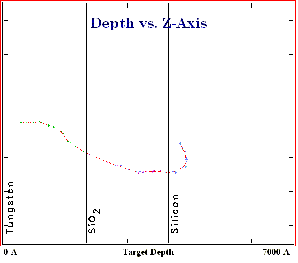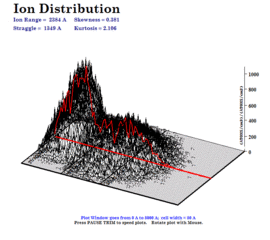 SRIM - 2013
SRIM - 2013
The Stopping
and Range
of Ions in Matter


SRIM-2013
This version of SRIM contains extensive 3-D graphics of the calculations. Computers have reached speeds to allow this to be done in real time. During a TRIM calculation, look at the lower-left menu for instructions about how to display 3-D plots. Usually, it is helpful to suspend the TRIM calculation while doing this by pressing "PAUSE" at the top of the window. Below, are typical plots for the DAMAGE in targets.
.gif)
SRIM-2010
SRIM-2010 includes NO changes to the basic calculations of SRIM-2003, but includes improvements to allow various specialized calculations :
(1) Many small bugs which have been reported have been corrected.
(2) It is now possible to add range and damage spectra from different ions at different energies and angles into to a single spectra. During the TRIM calculation, one can Pause TRIM, and then Change TRIM. You then have the option of adding the new data to the old datafiles. This was not considered reasonable for slower PCs, because of the need to recalculate all the ion/target interaction files, but new PCs work so fast that this takes less than 10 seconds. This topic is covered in Tutorial #1 for SRIM.
(3) The new SRIM textbook is available. It has been 23 years since the original textbook, and much has been learned and added to the textbook, which is now about twice the size of the original one (about 400 pages). (See SRIM textbook description)
SRIM-2006
SRIM-2006 includes NO changes to the basic calculations of SRIM-2003, but includes improvements to allow various specialized calculations :
(1) You can now download the complete plots showing the experimental/theoretical stopping of any ion in any elemental target. This file is large (20MB+) but it contains over 22,000 experimental data points reported since 1899. These plots may be accessed using the button on the SRIM-2006 initial window.
(2) The Error Message "The number of recoils has exceeded SRIM memory" has been fixed. The fix has been tested for up to 1M recoiling atoms in a recoil cascade from a single recoil event, Typically, you run into this problem when you use heavy ions with high energies, approaching a GeV, in which a single collision can transfer a large amount of energy, and the recoiling atom may generate up to a million further recoils. If the number of recoils exceeds the current TRIM memory allocation, the above error message will pop up and explain how to enlarge the TRIM memory to fix the problem. The number of allowed recoils can be increased using the file: /Data/SRIM.cfg. This file contains instructions on how to increase the number of allowed recoils.
(3) You can now make a file EXYZ.txt which shows the position of the incident ion at discrete energy points. For example, for Bi(500 keV) you can make a file showing its position at 100 keV increments. This option is at the bottom of the new TRIM input window, along with a Help and an example.
(4) You can now enter individual damage energies for each atom in each layer. Hence, silicon in crystalline silicon can have different displacement and Binding energies that silicon in a separate SiO2 layer. This improves both damage calculations and sputtering calculations.
(5) The TRIM output window "SHOW LIVE DATA" has been improved. FYI, this is a button in the TRIM window during the calculation. It is on the upper left corner. I think most people don't know it exists, but some people find it very useful for ions with large recoil cascades. They can see what is going on.
The following were improvements in
SRIM-2003 :
A "module" has been made so that the stopping and ranges of SRIM may be run as a batch sub-program for other applications. This allows the user to use SRIM as a sub-routine of another application that needs stopping powers and ranges. The user creates a control file and executes the file "SRModule.exe" which will generate an output table similar to those normally made by SRIM. The user can generate the standard file (with stopping and ranges) or can generate a file which contains stopping powers for a specific list of energies. For full instructions, see the file: "/SR Module/HELP SR Module.rtrf".
The stopping in Compounds has been given new attention. On this website, citation lists for the stopping and range of ions in more than 100 compounds are available. In SRIM, the stopping of more than 150 compounds are evaluated and suitable corrections can be applied for the bonding states. This significantly improves accuracy over the use of Bragg's rule, which merely sums the stopping for the elemental constituents of compounds, and ignores changes due to chemical bonding. The bonding corrections range up to 20% and are essential for accurate stopping and range calculations.
A full catalog of plots are available on the website. They show the accuracy of the stopping and ranges produced by SRIM. Over 500 plots are included. SRIM calculations are plotted along with 25,000 experimental data points. References to the citations which produced the experimental data are included. Below is a table showing the improvements in SRIM's stopping power accuracy when compared to experimental data. The right two columns shows the percentage of data points within 5% and within 10% of the SRIM calculation. As shown in the plots, the experimental stopping powers for heavy ions contains far more scatter than for light ions. Hence this larger error for ions Be-U is partly due to increased scatter of the data points.
Accuracy of
SRIM Stopping Power Calculations
|
|
Approx.
Data Pts.
|
SRIM-1998
|
SRIM-2010
|
SRIM-2010
(within 5%)
|
SRIM-2010
(within 10%)
|
H ions
|
8300
|
4.5 %
|
4.0 %
|
74 %
|
87 %
|
He ions
|
6500
|
4.6 %
|
3.9 %
|
76 %
|
89 %
|
Li ions
|
1400
|
6.4 %
|
4.8 %
|
72 %
|
83 %
|
Be - U Ions
|
9000
|
8.1 %
|
5.8 %
|
58 %
|
82 %
|
Overall Accuracy
|
|
6.1 %
|
4.6 %
|
69 %
|
86 %
|
Table Notes:
The above table includes all data points. If wacko points are omitted (those differing from SRIM by more than 25%) then all of the above accuracy numbers would be reduced by about 20%. The overall accuracy of SRIM-2010 then reduces to 4.0%.
Approx. Data Points : Current total data points used in SRIM plots.
SRIM-1998 : Comparison of SRIM-1998 stopping to experimental data. SRIM-1998 was last major change in stopping powers.
SRIM-2010 : Current stopping power calculation
SRIM-2010 (within 5%) : Percentage of experimental data within 5% of the SRIM values.
SRIM-2010 (within 10%) : Percentage of experimental data within 10% of the SRIM values.
![]()
Because this is an early release of the code, there are bound to be bugs. Please send any comments to: Ziegler@SRIM.org.